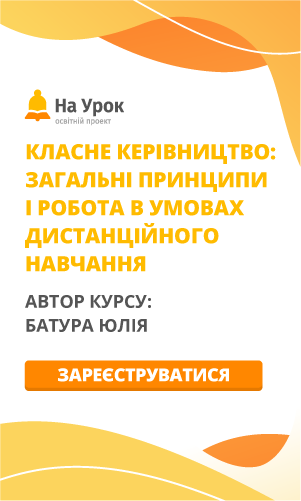Стаття "Поради щодо організації гібридного навчання"
Some advices for organizing hybrid learning
In the realities of wartime, all participants of the educational process experience excessive psychological stress, which causes apathy in children, overwork and burnout in teachers. Therefore, the question of organizing the educational process with the maximum level of efficency of all its participants has become particularly acute.
The students of our school are in different life circumstances. Some of them have changed their place of residence, are forced to hide with their parents in bomb shelters several times a day. Some of them were taken abroad by their parents. Fortunately, it is relatively calm on the territory of our community. Therefore, it was decided to introduce hybrid learning in our school in order to involve children in the educational process as much as possible.
Hybrid learning is: a combination of elements of traditional education and online lessons; educational methodology, teaching and approach that combines traditional classroom methods with computer-based learning activities; combination of pedagogical theories and technologies; continuous improvement; the combination of various technologies into a single integrated educational approach with the constant development of information and communication technologies and electronic resources.
All students are different, perceive information in different ways, at different tempo. Hybrid learning itself is aimed at helping students. They will be able to acquire knowledge independently, and face to face with the teacher. The main component of distance learning is the independent work of students outside the classroom. That’s why, the following conditions are necessary for the organization of students' work: motivation for independent work; availability of educational and methodological support and reference material; availability of computer classes; a system of regular quality control of performed independent work; consultation of the teacher. Nowadays, learning technologies are changing especially quickly and significantly. Offline training develops communication skills, gives an opportunity for reflection and feedback.
What approaches and tools should be used so that teachers can work according to a fixed work schedule, students have access to all necessary information, and their parents do not need to study the teaching profession? Probably, the optimal option in this situation will be the organization of hybrid training, since this form combines face-to-face and remote forms and at the same time is more effective than each of them separately. It is highly desirable to create conditions for communication between all participants of the educational process online. Each class will study with its own teachers and interact with them during lessons.
Organizing hybrid education, the teacher must take certain points into account:
Write a plan for each part of the lesson. Online and offline training have different methodical specifics, speed of learning activities and tools. However, points of contact must be found so that all participants have a sense of interaction and togetherness. The most convenient option is to give online and offline participants the opportunity to work in separate groups, and for certain key activities to combine them into one. From experience, such trainings are the best. The choice of platform, the schedule of live broadcasts, the format of submission of work - these are not just elements, but a system that works well if thought out in advance.
Optimally synchronize online and offline. In hybrid education, it is very important to create a sense of community, so that students, despite physical separation, feel like a single educational group. For this, you need to include in the program elements that will combine online and offline. At the beginning, conduct a briefing for both groups so that each group understands the procedure. And during the lesson, unite the groups within the framework of tasks for reflection, warm-up or summing up the results of group work.
Consider the technical capabilities of the classroom. A simple checklist is suitable for this:
- what equipment is there in the classroom and how can it be usedoptimally? For full interaction, you need to provide good sound and video.
- is additional equipment needed? For example, a microphone, speakers or a camera.
- does the technology in the classroom support the necessary software?
Take into account the location of the equipment and the position of the teacher.
- if the microphone is stationary, then you cannot go far;
- it is important to think about the location of the teacher in relation to the camera in advance and remember it throughout the lesson, so that the teacher does not turn his back to the online students for a long time. It is better to install the camera as far as possible for a better view.
Think how to monitor the process and progress better.
If the teacher is alone. Set aside time in advance for feedback (reflection), student support and tracking of their progress. Think about how to do this for each part of the lesson. The main life hack is pauses.
If there is an assistant. In this case, the teacher of the online group will monitor the chat, answer questions in time and assign students to rooms in Zoom, while the teacher in the classroom will establish interaction and help those who are present in theclassroom.
Connect online participants to informal communication. For example: you can "exchange" screens between offline and online groups: online students are shown "backstage", that is, what happens during breaks, and those who participate remotely are shown on the screens in the classroom. You can also broadcast jokes and informal comments made by students of both groups during the learning process, or invite participants to discuss a situation. Working on a shared virtual whiteboard can be an effective option. And even better — to provide practice skills in game form.
Create projects. It develops communication skills of schoolchildren. But it will be necessary not only to demand the result but also to satisfy the students' communication needs. Projects for the group should be given in such a way as to unite them and allow them to talk with friends. The joy of communication in difficult times and mutual support are no less important than formulas and exercises.
Ensure the balance of the lesson. You should not overload the class with either information or fun: everything should be in moderation. The teacher needs to focus on solving the needs of students, on their requests. Within each lesson and topic, you should have several options and offer them to children. This is especially important in the conditions of war, when daily stress is already too great.
So, under the condition of properorganization, hybrid education makes it possible to implement a differential approach, personalize learning, organize independent and team work of students, create conditions of accessibility to educational materials, diagnose the quality of knowledge with the help of computer technologies, use WEB-oriented, cloud and information technologies.
Список використаних джерел
1.Кухаренко В. М. Теорія та практика змішаного навчання: монографія/ С. М. Березенська, К. Л Бугайчук, Т.О.Олійник,О.В.Рибалко та ін.; за ред. В. М. Кухаренка. Харків : Міськдрук, НТУ ХПІ, 2016.
2.Триус Ю. В., Герасименко Ю. В Комбіноване навчання як інноваційна освітня технологія у вищій школі . Теорія та методика електронного навчання : збірник наукових праць. Випуск ІІІ. - Кривий Ріг, 2012
3.BlendedLearning. [Електронний ресурс]. URL: https://www.christenseninstitute.org/blendedlearning/.


про публікацію авторської розробки
Додати розробку
